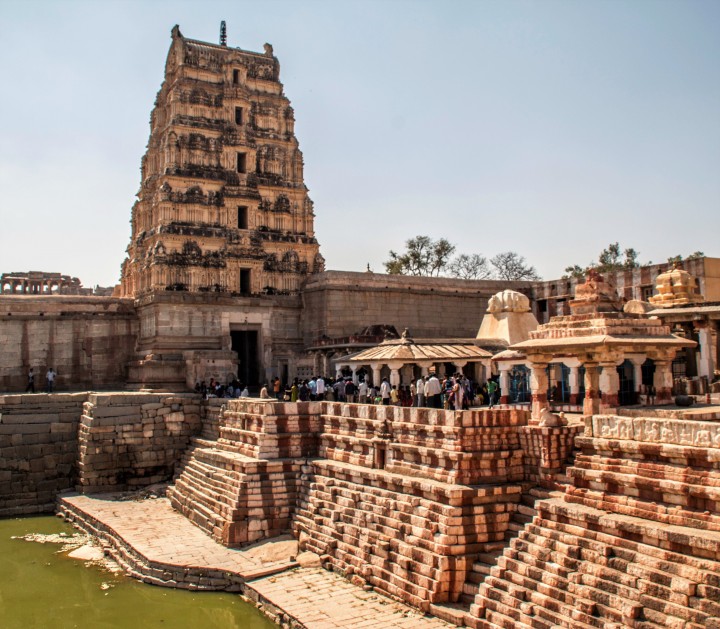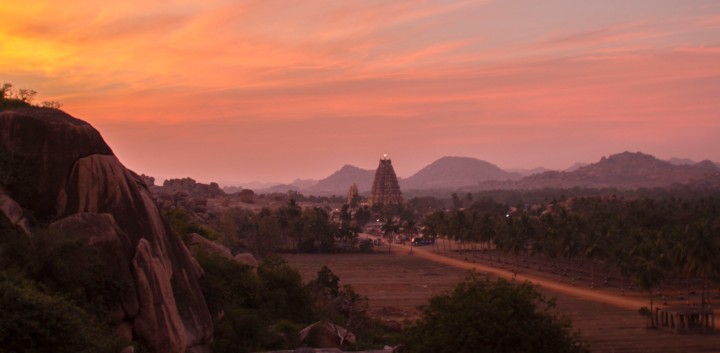“Hampihampihampihampi!” announced the bus driver, waking us up from our uncomfortable half-sleep as the rattlebox sleeper coach from Goa pulled in at 6:30AM. We fought our way off the bus through the tuk-tuk drivers scrambling for our business, then found ourselves blinking at a bizarre alien landscape in the half-light of the morning. We had parked up in a long avenue of half collapsed stone columns, a giant pyramid at one end and a strange pile of round, orange boulders at the other, looking like giant pebbles stacked by a playful giant. This was Hampi, perhaps the most surreal and otherworldly historical site in India, if not the world. Half a millennium ago, it was the capital of Southern India with half a million people. Now it’s a small but lively tourist village nestling in a forest of boulder piles which shelter countless ruined temples and palaces. Hampi is all about atmosphere, whether it’s picking your way through the dusty ruins, gazing out across the valleys during a psychedelic sunset, or sitting in one of the handful of cliché traveller bars listening to Pink Floyd with a Bhang Lassi, if you’re into that sort of thing.

Despite the small size of Hampi village, it’s a lively and interesting place with plenty of places to stay. Vicky’s guesthouse was simple and clean, but somewhat overpriced. Furthermore, the manager was pushy for us to use his in house services. He offered us a starting price of 1200 to take his cousin’s tuk-tuk tour and had a tantrum when we took up the offer of 800 from somebody else. He even followed us into a neighbouring cafe to ask us why we weren’t eating his breakfast!
South of the River
The majority of Hampi’s historical sites lie south of the river which snakes its way through the valley. However, the best way to see them is not by overpriced tuk-tuk tour, guesthouse owner’s cousin’s or otherwise. We did it and the five whistle-stop hours were relentless and only served to induce temple tedium. We very quickly reached saturation point, our driver taking us to the famous Vittala stone chariot last, and after twenty similar temples and the crowds of school children, we weren’t really in the mood to appreciate it. Our conclusion: don’t try to see all of the sites at once. Take your time. If you’re pressed for time, many of the temples are frankly superfluous. We advise hiring a bicycle, setting yourself off at a leisurely pace, and visiting the following 5 places if nowhere else:
- The main bazaar area next to Hampi village for the Virupaksha temple towers and massive monolithic Ganesha, just up the hill to the south.
- The Vittala complex for the famous stone chariot and surrounding temples which feature impressive brick and plaster sculptures. Beware that the temples cost 500 rupees to get in are a long walk from the entrance – you can get a golf buggy for 10 rupees.
- Zenana enclosure for the vast elephant stables and decorative watch towers – also accessible on the Vittala ticket.
- Matanga hill for breathtaking views of the whole site and stunning technicolour sunsets
- Achutaraya bazaar and temple, behind Matanga hill for exquisite carvings (spot the rude ones) and deserted lost-city atmosphere.




The sunsets in Hampi are spectacular and add a psychedelic filter of vivid oranges and purples to the already mysterious atmosphere. From the far end of the main bazaar, we took the steps leading up from the right up to Matanga Hill. The view from the roof of the temple at the top is not only breathtaking, but allows you to appreciate the huge scale of this once mighty city.

We heard rumours of a spectacular waterfall which offered crystal clear swimming pools amidst cascading waters. Finding the waterfall was difficult because the signs had been removed by enterprising farmers hoping to make a buck guiding tourists through the plantations. Turning their offer down, we inevitably got lost amidst the banana trees. Luckily, salvation came in the form of English voices – we tracked down some people who know where they were going and followed them to the waterfall. Being the middle of the dry season, it was really just a pool amidst the rocks, but the landscape was spectacular and the water was nice and cool for swimming in.
Across the River
North of the river has further delights which require a little exploration. If you’re adventurous and don’t mind getting wet, you can wade across the river which is shallow in dry season, or you can fork out a whole 10 rupees to get on the small ferry which will take you to the other side – you have to wait until it’s full though. There’s a smaller traveller village of guesthouses and hostels here, and once you’ve obtained your transportation (from one of the many people who’ll offer as soon as you step off the boat) the Hanuman temple is within easy reach. Balanced on top of one of the rock piles, this white building is visible from all over Hampi and offers commanding views of the whole valley. We’re told it’s spectacular at sunrise, but we never got up early enough to test this. The 500 white steps to the top weave their way through the giant boulders and families of monkeys, including one with no hands (who didn’t seem to find this at all an inconvenience while eating sticks of sugar cane held in her toes, or clambering her way across the rocks). Further along the road, we quite mistakenly stumbled across an ancient, ruined fort perched on top of the hill opposite. Find the the elaborate gate for the Durga temple off the main road, walk through the temple, admire the tree enveloped in coloured shrouds holding sacrificial coconuts, watch the monkeys as they try to figure out how to get inside, then keep walking. You’ll find a temple inside a small cave called Shanmukha Mandir, then a ruined gate which marks the entrance to the fort. Arrows painted onto the rocks point you to the ruined walls, where a path will take you all the way around. Be careful of cobras!





Hope both of you an pleasant new year on amazing travel! i am sure you will be happy! hope we can meet in Myanmar, New Zealand or Austrilia~~~~keep updating~Nan
LikeLike
Really good writeup!Was wondering if you can give more details about this waterfall??Like how to get there/any landmarks??Would be really helpful!
-Priyanka
LikeLike
Thanks. Waterfalls are tricky to find – and not very visible. They are basically under huge rocks but you can swim in a great calm pool. Take the road behind the temple in town into the banana plantation. Where the road ends, take a right turn on foot through fields, over a small stream and then climb over boulders for 15 mins. You’ll see people selling water who can guide you. Enjoy!
LikeLike